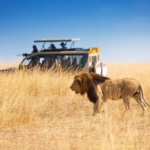Welcome, young explorers, to our safari of knowledge! Today, we’re diving into the lush jungles, vast oceans, and arid deserts of our planet to discover the fascinating creatures that call these habitats home. From the majestic elephant to the tiny hummingbird, each animal plays a crucial role in the tapestry of life. So, grab your explorer’s hat, and let’s embark on an adventure to learn about different types of animals, their unique homes, and the heroic conservation efforts to protect them.
The Majestic Inhabitants of Our World
1. The Jungle’s Symphony
In the heart of the jungle, where sunlight filters through the dense canopy, lives a diverse community of animals. Here, you can find the powerful jaguar, its spotted coat blending seamlessly into the underbrush, making it a silent and effective predator. High above in the treetops, colorful parrots and toucans add splashes of color to the green expanse, their calls echoing through the air.
Jungles, often referred to as rainforests, are crucial for the survival of these species. They provide not just a home, but a complex ecosystem that offers food, shelter, and mating opportunities. Unfortunately, deforestation poses a significant threat to these vibrant habitats. According to the World Wildlife Fund (WWF), nearly 17% of the Amazon rainforest has been lost in the last 50 years due to human activities.
2. Oceans: The Blue Frontier
Beneath the rolling waves of our oceans, a whole new world awaits. The ocean is home to the majestic blue whale, the largest animal to have ever lived on our planet, reaching lengths of up to 100 feet. Alongside these gentle giants swim the clever dolphins, known for their playful nature and intelligence.
Oceans cover more than 70% of the Earth’s surface and are vital for the health of our planet, providing oxygen and regulating the climate. However, pollution and overfishing threaten marine life. Initiatives like the Marine Conservation Society work tirelessly to combat these issues, aiming to protect our oceans and the myriad of life within them.
3. Deserts: Lands of Extremes
Deserts, though seemingly barren, are alive with activity. The fennec fox, with its oversized ears, roams the sands of the Sahara, while the resilient camel traverses these arid landscapes with ease. These animals have adapted to survive in extreme conditions, from scorching days to freezing nights.
Deserts make up about one-third of the Earth’s surface. They are not just sandy expanses but include rocky and icy deserts as well. Conservation efforts in these regions focus on water conservation and protecting endangered species from the threats of habitat loss and illegal wildlife trade.
Our Role in Conservation
Conservation is not just for scientists and activists; it’s a responsibility we all share. By learning about these animals and their habitats, we can begin to understand the impact of our actions on the natural world. Simple acts, such as recycling, reducing plastic use, and supporting wildlife conservation organizations, can make a big difference.
Fun Facts to Feed Your Brain
- Did you know that elephants communicate over long distances using low-frequency sounds that humans can’t hear?
- Sea turtles have an incredible sense of direction and can navigate across oceans to return to the beaches where they were born to lay their eggs.
- The Arctic fox changes color with the seasons, from brown in the summer to white in the winter, to blend in with its surroundings.
How You Can Help
You don’t have to be a grown-up to make a difference! Here are some ways you, as young conservationists, can help protect our planet’s incredible wildlife:
- Learn and Share: The more you know about animals and their habitats, the more you can teach others. Sharing your knowledge can inspire your friends and family to care about conservation.
- Participate in Local Cleanups: Joining a beach or park cleanup can help protect animals’ homes from pollution.
- Support Wildlife Organizations: Consider adopting an animal through a wildlife charity or donating to conservation projects.
- Caring for our pets: Just like wild animals, our domestic companions (such as Border Collie or Pugs) require love, attention, and care to thrive. Caring for a pet teaches us responsibility, compassion, and respect for all living beings. By taking care of our pets, we learn the importance of stewardship for all creatures, big and small. Every meal provided, every walk taken, every cuddle shared contributes to a pet’s well-being and deepens the special bond between humans and animals.
Conclusion: Guardians of the Earth
Our journey across the globe may have come to an end, but our adventure as guardians of the Earth is just beginning. Each animal we’ve learned about today, from the depths of the ocean to the heart of the jungle, plays a vital role in our world’s biodiversity.
By taking steps to protect their habitats and raise awareness about conservation, we ensure that future generations can enjoy the wondrous diversity of life on our planet.
Remember, young explorers, the future of our planet’s wildlife is in our hands. With curiosity, compassion, and courage, we can make a difference. Let’s continue to learn, explore, and protect the magnificent world around us. The safari of knowledge never ends, and each of us has the power to contribute to the story of conservation. Onward, to our next adventure!



